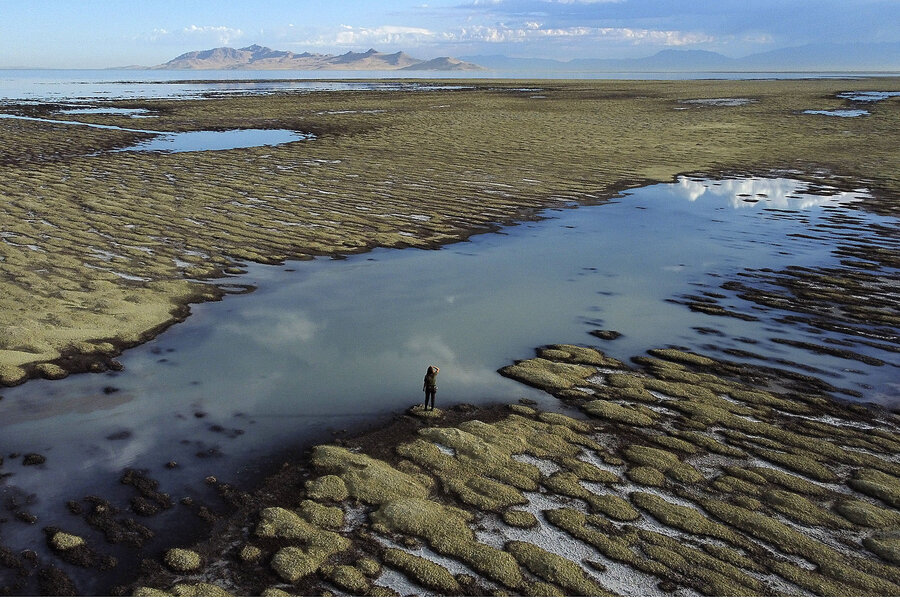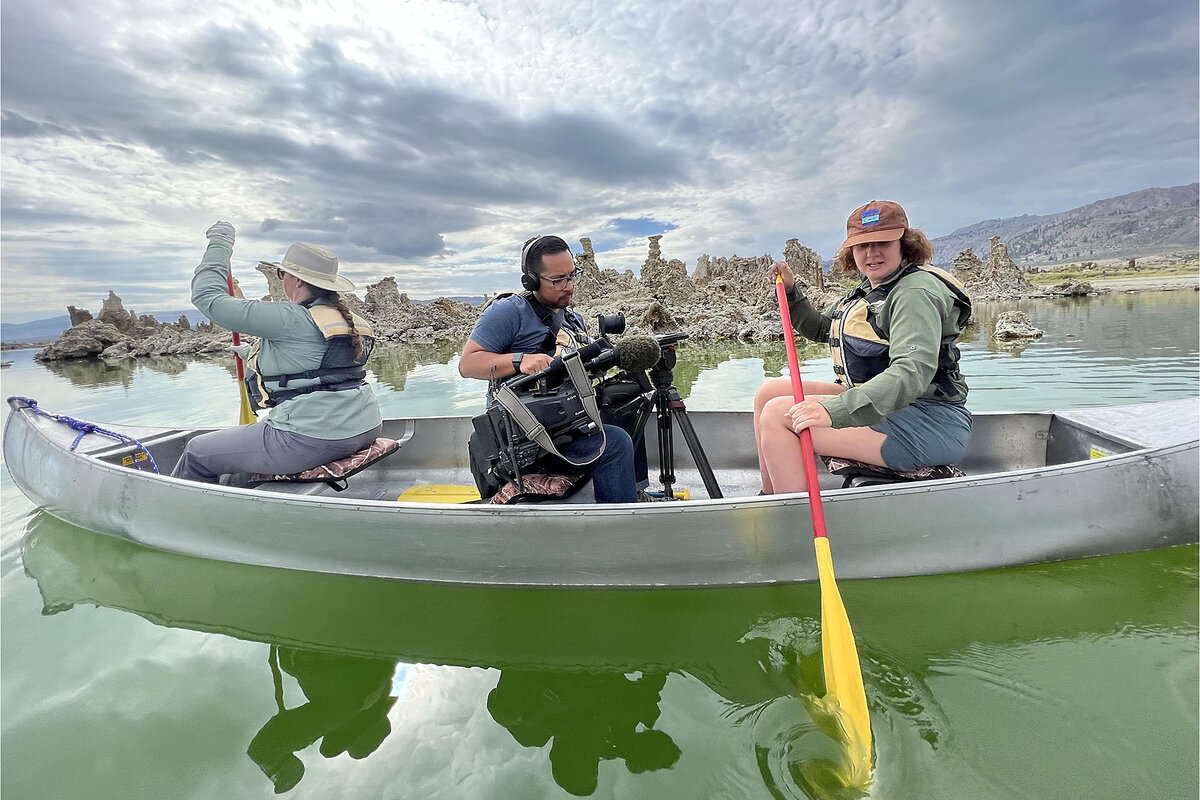Utah media competitors unite on Great Salt Lake project
Loading...
When the Great Salt Lake sank to its lowest levels on record, a group of Utah journalists were busy looking for hope. They formed the Great Salt Lake Collaborative to invest in a solutions-driven approach to covering the health and environmental concerns arising from the lake’s shrinking shores.
The collaborative of now 19 news, community, and education partners began in 2022 through a grant from the Solutions Journalism Network. Trust in a solutions approach has meant investing in relationships with readers through events like panel presentations and a book club. Participating newsrooms have sent local reporters to study similar water issues in California, Israel, and Kazakhstan.
Why We Wrote This
A story focused onLocal newsrooms in Utah are trusting collaboration over competition to shore up solutions for the critically low water levels of the Great Salt Lake.
Trust has taken another form, too, as former newsroom competitors turn to collaboration, says Heather May, director of the Great Salt Lake Collaborative and a lifelong Utahn. Ms. May spoke with the Monitor about the group’s distinctive coverage, and what its impact looks like.
“Focusing solely on the crisis doesn’t create room for people to get involved or to feel hope that what they do matters,” says Ms. May. “That’s why this collaborative has been so important to the community and helped really engage the community, because we focus on solutions.”
When the Great Salt Lake sank to its lowest levels on record, a group of Utah journalists were busy looking for hope. They formed the Great Salt Lake Collaborative to invest in a solutions-driven approach to covering the health and environmental concerns tied to the lake’s shrinking shores.
The collaborative of now 19 news, community, and education partners began in 2022 through a grant from the Solutions Journalism Network, which has also funded separate Monitor coverage. Trust in a solutions approach has meant investing in relationships with readers and sending local reporters to study similar water issues in California, Israel, and Kazakhstan.
Trust has taken another form, too, as former newsroom competitors turn to collaboration, says lifelong Utahn Heather May, director of the Great Salt Lake Collaborative. Ms. May spoke with the Monitor about the group’s distinctive coverage, and what its impact looks like. The conversation has been edited and condensed.
Why We Wrote This
A story focused onLocal newsrooms in Utah are trusting collaboration over competition to shore up solutions for the critically low water levels of the Great Salt Lake.
The picture of the lake is grim. How do you cultivate hope for solutions and build audience trust in your approach?
I’m a former daily print reporter. As journalists we’re good at pointing out problems, right? And that’s really crucial to do.
But I think focusing solely on the crisis doesn’t create room for people to get involved or to feel hope that what they do matters. That’s why this collaborative has been so important to the community and helped really engage the community, because we focus on solutions.
That doesn’t mean that we don’t talk about the problem. We’ve talked about the problem with the shrinking lake, the growing lake bed, more dust storms. … But this grant catalyzed the focus of: What’s working elsewhere? Nobody has saved a lake that has reached this level before. But there are other communities that conserve water differently than Utah.
We don’t advocate for solutions. So we’re not saying that the way Las Vegas has saved a lot of water is the way for Utah. Our role is to go out and say: Here’s what’s happening in this community. What are the limitations of this response in Las Vegas? What are the insights that Utahns can learn from? That has created trust among our audience. And it has translated into quite a lot of involvement by the public.
What does that involvement look like?
We create events to engage the public. One of our community partners is the Community Writing Center at Salt Lake Community College. Anybody who submitted their fiction, nonfiction, artwork, got into an anthology that we created. Then we held a gala. … We’ve done library panels. We created a book club.
But more broadly, the coverage has resulted in people in Utah caring about a lake that they really forgot. They thought it was just a stinky place to avoid and a waste of water. Now a poll has found 74% of Utahns are concerned about its drying. There was just a rally, late January, at the [Utah State] Capitol. Twelve-hundred Utahns came out, rallying for the lake’s future. Some were wearing brine shrimp costumes, bird costumes, bird masks.
There are leaders of different faith groups who are advocating together for the lake. There’s a youth lake coalition that meets with farmers and lobbies policymakers. There are lawsuits about the lake now. Lawyers and scientists have created their own sort of collaboratives to accelerate policy changes for the lake. And Utahns are buying up low-water grass seed and ripping out their lawns in a groundswell of involvement.
I’m wondering how the Great Salt Lake Collaborative measures its impact.
We measure impact in a couple of ways. You could look at the number of news stories that the collaborative has produced – nearly 600 in two years.
Another way of measuring impact is for the newsrooms to work together on a project. We’ve sent a team of reporters from formerly competing newsrooms together to cover Las Vegas. Same with reporters going to California for Owens Lake and Mono Lake. I do look at the engagement piece – all of the community involvement – as impact, and those polls that show how much people care about the lake now.
Public policy change is another huge impact. Lawmakers say they’ve done more than ever before for the lake and on water issues since 2022, which is when we formed. … The Church of Jesus Christ of Latter-day Saints has donated permanent water rights to the lake.
Can we take credit for all that? Of course not. Part of the reason so many people are engaged in this topic is also because, of course, the lake sunk to its lowest level ever recorded [in fall 2022]. But we have been told by policymakers and advocates and regular folks that we have changed Utahns’ relationship to the lake. Made them care about it. You can see how that’s translated into action.
What’s next for the collaborative in 2024?
We will continue to focus on the Great Salt Lake. In our first year, we showed what was at stake. In our second year – and in our first year – we pointed to evidence-backed solutions. Third year going forward, we are looking at: Is water making it to the lake? There have been a lot of structural changes that have happened in law and policy that policymakers say sets it up so that more water will get to the lake. I don’t want to speak for what all the newsrooms are going to be doing, because they choose what they cover. But I think the public wants to see if water has made it to the lake.
What gives you hope?
I want to give a shoutout to these newsroom partners. They put aside their longtime competition, and even the drive for page views, because all of their work is shared with other newsrooms, and it’s shared on the Great Salt Lake site. I want to shout out their willingness to do that and be such amazing, collaborative partners, because they have put the community first. I think that local journalism – local journalists – need to be celebrated for the work they’ve done.









